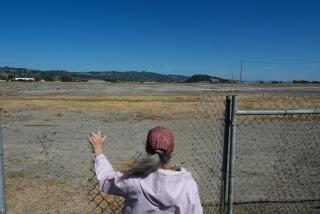Work to Halt Dump Seepage Nearing End
Crews from the U.S. Environmental Protection Agency took samples of acid sludge oozing to the surface of Fullerton’s McColl hazardous waste dump Thursday, as work to halt seepage at the site wound down.
William E. Lewis, the EPA’s on-scene coordinator for the weeklong project, said that samples of the wasete would go to the state Department of Health Services for testing of possible methods to neutralize the toxic aviation fuel waste.
Lewis said that workers have removed 100 cubic yards of surface soil at the dump and plan to finish test borings today at the dump’s southern border to determine if the sludge is moving toward homes.
The corrosive waste had oozed through a protective cap to the surface in several spots at the eight-acre dump, prompting concern for renewed noxious air emissions into surrounding neighborhoods.
It was hoped that removing a layer of surface soil would alleviate pressure on the jelly-like sludge and halt the seepage while lengthy environmental studies on the cleanup continue.
A $26.5-million federal Superfund cleanup project to remove the foul-smelling sludge was blocked last May when a Superior Court judge in Kern County ordered the state to do a full environmental impact report.
The sludge contains sulfuric acid, benzene and arsenic. Before a canvas cover and layers of dirt were placed over the sumps, sulfur dioxide fumes caused residents to suffer headaches, nausea and respiratory problems, especially during hot weather.
On Thursday, Lewis said air-monitoring equipment detected only background levels of noxious fumes near the excavation work.
All work is expected to be finished by early Saturday, Lewis said. Excavated soil--about 5% of which is contaminated with sludge from about four surface seepages--will be sealed between two huge layers of plastic and left on the site.
More to Read
Sign up for Essential California
The most important California stories and recommendations in your inbox every morning.
You may occasionally receive promotional content from the Los Angeles Times.










